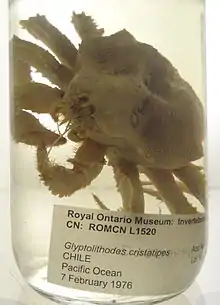Glyptolithodes
Glyptolithodes cristatipes, also known as the Peruvian centolla, is a species of king crab, and the only species in the genus Glyptolithodes.[3] The species was briefly placed in the related genus Rhinolithodes after its initial description, but was soon moved to its own genus.[3]
| Glyptolithodes cristatipes | |
|---|---|
 | |
| Glyptolithodes cristatipes specimen | |
| Scientific classification | |
| Kingdom: | |
| Phylum: | |
| Subphylum: | |
| Class: | |
| Order: | |
| Family: | |
| Genus: | Glyptolithodes |
| Species: | G. cristatipes |
| Binomial name | |
| Glyptolithodes cristatipes | |
| Synonyms | |
|
Rhinolithodes cristatipes Faxon, 1893 [3] | |
Distribution
G. cristatipes is found off the Pacific coasts of South America, especially Chile and Peru, and extending as far northwards as Southern California,[3] and as far south as 33° 35' S.[4] The most closely related genera to Glyptolithodes all live in the Northern Hemisphere, suggesting that Glyptolithodes has migrated from its ancestral home to the Southern Hemisphere, where it is now most abundant.[3]
Dimorphism
This species shows notable sexual dimorphism, with the males have a right cheliped which is larger than the left.[4]
References
- "Glyptolithodes". Integrated Taxonomic Information System. Retrieved October 6, 2010.
- "Glyptolithodes cristatipes". Integrated Taxonomic Information System. Retrieved October 6, 2010.
- Joel W. Martin, Carlos A. Sanchez & Ricardo Pereyra (1997). "Notes on the distribution of two lithodid crabs (Crustacea: Decapoda: Anomura) from off the coast of Baja California Sur, Mexico" (PDF). Bulletin of the Southern California Academy of Science. 96 (2): 78–86.
- José Luis Brito M. (2002). "Lithodidae registrados frente a San Antonio, Chile central (Crustacea, Anomura)" (PDF). Investigaciones Marinas (in Spanish). 30 (1): 57–62.